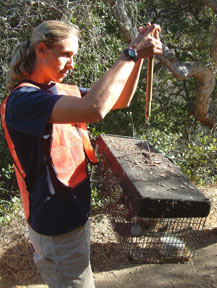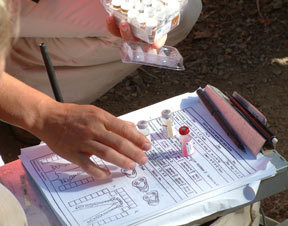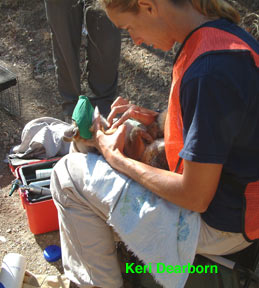Island Fox Questions
Friends of the Island Fox is committed to connecting the community with the problems and issues concerned with protecting island foxes. When we receive questions, we want to bring you answers directly from the people in the field with these endangered animals. We received a great question from a student and were able to get a first-hand response.
hi this is a student from balboa middle school. i loved the presentation we got on Wednesday March 11, 2009. the video they showed us was very cute!!!! i have a few questions:
Sara is an Island Fox Technician for Channel Island National Park on Santa Rosa Island, she answered:
 Hi Anastasia,
Hi Anastasia,
Good questions.
Most of the injuries to island foxes have come from mate aggression during breeding (winter/spring) season. This was more common in our captive [breeding] population but has been documented in the wild population as well. These injuries include minor bites and tears around the ears, to more significant trauma involving rips, bites and abscesses (infected pockets under the skin) in various places. The foxes are actually fairly aggressive and scrappy toward one another during this time of the year.
Other common injuries include foxtails stuck in an eye or ear and torn toenails, these usually don't require any additional treatment beyond the time of observance. And, every now and then with the captives, we would find a case of ringworm, exciting.
Each island has a clinic called a "Foxpital" and is set up like a small veterinary clinic with all the necessary equipment to properly care for an ill or injured fox. When a fox requires care, they are brought into the foxpital and given an initial assessment by one of our staff fox biologists, from there a veterinarian is consulted to determine the best course of treatment. If necessary, we have veterinarians on call who can come out and perform emergency procedures on the island. Each animal's stay is dependent on the nature and extent of their injury. Most often, if an injury requires a stay in the foxpital, the animal is in for a week or so. In very rare cases we have cared for animals as long as three months.
Thanks for your interest in the island fox,
Sara
Island Fox Technician
Channel Islands National Park
Santa Rosa Island
Other stories on injured foxes:
Fox and the Fishing Lure
Burnie Boots
Your Donations to Friends of the Island Fox support conservation efforts across all of the Channel Islands to help island foxes.
hi this is a student from balboa middle school. i loved the presentation we got on Wednesday March 11, 2009. the video they showed us was very cute!!!! i have a few questions:
- how often do the island foxes get hurt?
- when you take them to the hospital does it hurt the foxes?
- how long was it until you let the foxes free from cativity?
Sara is an Island Fox Technician for Channel Island National Park on Santa Rosa Island, she answered:
 Hi Anastasia,
Hi Anastasia,Good questions.
Most of the injuries to island foxes have come from mate aggression during breeding (winter/spring) season. This was more common in our captive [breeding] population but has been documented in the wild population as well. These injuries include minor bites and tears around the ears, to more significant trauma involving rips, bites and abscesses (infected pockets under the skin) in various places. The foxes are actually fairly aggressive and scrappy toward one another during this time of the year.
Other common injuries include foxtails stuck in an eye or ear and torn toenails, these usually don't require any additional treatment beyond the time of observance. And, every now and then with the captives, we would find a case of ringworm, exciting.
Each island has a clinic called a "Foxpital" and is set up like a small veterinary clinic with all the necessary equipment to properly care for an ill or injured fox. When a fox requires care, they are brought into the foxpital and given an initial assessment by one of our staff fox biologists, from there a veterinarian is consulted to determine the best course of treatment. If necessary, we have veterinarians on call who can come out and perform emergency procedures on the island. Each animal's stay is dependent on the nature and extent of their injury. Most often, if an injury requires a stay in the foxpital, the animal is in for a week or so. In very rare cases we have cared for animals as long as three months.
Thanks for your interest in the island fox,
Sara
Island Fox Technician
Channel Islands National Park
Santa Rosa Island
Other stories on injured foxes:
Fox and the Fishing Lure
Burnie Boots
Your Donations to Friends of the Island Fox support conservation efforts across all of the Channel Islands to help island foxes.
Labels: Channel Island fox, Channel Islands National Park, island fox, island fox health check, Santa Rosa island fox







